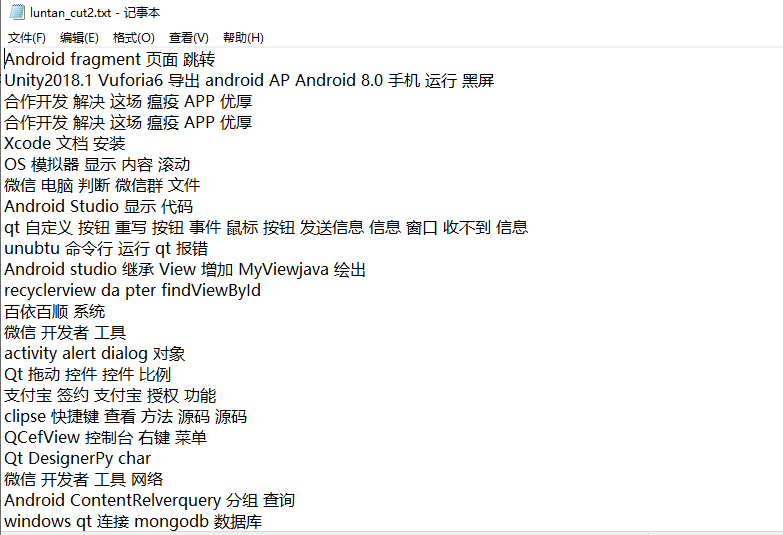源码如下:
1 import jieba
2 import io
3 import re
4
5 #jieba.load_userdict("E:/xinxi2.txt")
6 patton=re.compile(r'..')
7
8 #添加字典
9 def add_dict():
10 f=open("E:/xinxi2.txt","r+",encoding="utf-8") #百度爬取的字典
11 for line in f:
12 jieba.suggest_freq(line.rstrip("\n"), True)
13 f.close()
14
15 #对句子进行分词
16 def cut():
17 number=0
18 f=open("E:/luntan.txt","r+",encoding="utf-8") #要处理的内容,所爬信息,CSDN论坛标题
19 for line in f:
20 line=seg_sentence(line.rstrip("\n"))
21 seg_list=jieba.cut(line)
22 for i in seg_list:
23 print(i) #打印词汇内容
24 m=patton.findall(i)
25 #print(len(m)) #打印字符长度
26 if len(m)!=0:
27 write(i.strip()+" ")
28 line=line.rstrip().lstrip()
29 print(len(line))#打印句子长度
30 if len(line)>1:
31 write("\n")
32 number+=1
33 print("已处理",number,"行")
34
35 #分词后写入
36 def write(contents):
37 f=open("E://luntan_cut2.txt","a+",encoding="utf-8") #要写入的文件
38 f.write(contents)
39 #print("写入成功!")
40 f.close()
41
42 #创建停用词
43 def stopwordslist(filepath):
44 stopwords = [line.strip() for line in open(filepath, 'r', encoding='utf-8').readlines()]
45 return stopwords
46
47 # 对句子进行去除停用词
48 def seg_sentence(sentence):
49 sentence_seged = jieba.cut(sentence.strip())
50 stopwords = stopwordslist('E://stop.txt') # 这里加载停用词的路径
51 outstr = ''
52 for word in sentence_seged:
53 if word not in stopwords:
54 if word != '\t':
55 outstr += word
56 #outstr += " "
57 return outstr
58
59 #循环去除、无用函数
60 def cut_all():
61 inputs = open('E://luntan_cut.txt', 'r', encoding='utf-8')
62 outputs = open('E//luntan_stop.txt', 'a')
63 for line in inputs:
64 line_seg = seg_sentence(line) # 这里的返回值是字符串
65 outputs.write(line_seg + '\n')
66 outputs.close()
67 inputs.close()
68
69 if __name__=="__main__":
70 add_dict()
71 cut()luntan.txt的来源,地址:https://www.cnblogs.com/zlc364624/p/12285055.html
其中停用词可自行百度下载,或者自己创建一个txt文件夹,自行添加词汇用换行符隔开。
百度爬取的字典在前几期博客中可以找到,地址:https://www.cnblogs.com/zlc364624/p/12289008.html
效果如下:

import jiebaimport ioimport re#jieba.load_userdict("E:/xinxi2.txt")patton=re.compile(r'..')#添加字典def add_dict(): f=open("E:/xinxi2.txt","r+",encoding="utf-8") #百度爬取的字典for line in f: jieba.suggest_freq(line.rstrip("\n"), True) f.close()#对句子进行分词def cut(): number=0f=open("E:/luntan.txt","r+",encoding="utf-8") #要处理的内容,所爬信息,CSDN论坛标题for line in f: line=seg_sentence(line.rstrip("\n")) seg_list=jieba.cut(line) for i in seg_list: print(i) #打印词汇内容m=patton.findall(i) #print(len(m)) #打印字符长度if len(m)!=0: write(i.strip()+" ") line=line.rstrip().lstrip() print(len(line))#打印句子长度if len(line)>1: write("\n") number+=1print("已处理",number,"行")#分词后写入def write(contents): f=open("E://luntan_cut2.txt","a+",encoding="utf-8") #要写入的文件f.write(contents) #print("写入成功!")f.close()#创建停用词def stopwordslist(filepath): stopwords = [line.strip() for line in open(filepath, 'r', encoding='utf-8').readlines()] return stopwords# 对句子进行去除停用词def seg_sentence(sentence): sentence_seged = jieba.cut(sentence.strip()) stopwords = stopwordslist('E://stop.txt') # 这里加载停用词的路径outstr = ''for word in sentence_seged: if word not in stopwords: if word != '\t': outstr += word #outstr += " "return outstr#循环去除、无用函数def cut_all(): inputs = open('E://luntan_cut.txt', 'r', encoding='utf-8') outputs = open('E//luntan_stop.txt', 'a') for line in inputs: line_seg = seg_sentence(line) # 这里的返回值是字符串outputs.write(line_seg + '\n') outputs.close() inputs.close()if __name__=="__main__": add_dict() cut()来源:https://www.cnblogs.com/zlc364624/p/12289643.html